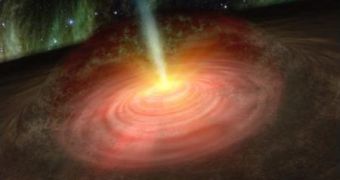Scientists operating the NASA Spitzer Space Telescope announce that they recently discovered large amounts of tiny crystals falling into a growing star. The crystals are in fact the green mineral olivine, which can be found deep in Earth's crust as well.
This phenomenon was observed in large gas clouds that tend to collapse as soon as they give birth to new stars. The chemicals they contain then tend to fall towards the forming stellar object, fueling its growth. The olivine minerals fall into this particular star from cosmic dust clouds.
Interestingly, if we accept these clouds as the origins of the mineral, then we are faced with a new problem – explaining how the stuff got there in the first place. Some experts believe that they were put there by stellar jets that originate on embryonic stars.
In order to make these types of crystals, geologists say, huge temperatures and pressures are needed. On Earth, olivine develops in the crust, where pressure from above and heat from the mantle meet the necessary criteria.
Spitzer made its new discovery while investigating the young star HOPS-68, which is located in the constellation Orion. “You need temperatures as hot as lava to make these crystals,” explains University of Toledo in Ohio expert Tom Megeath.
“We propose that the crystals were cooked up near the surface of the forming star, then carried up into the surrounding cloud where temperatures are much colder, and ultimately fell down again like glitter,” he goes on to say.
The expert is the principal investigator of the work, and was the second author of a study detailing the findings. Details of the work appear in the latest issue of the esteemed Astrophysical Journal Letters.
The class of minerals that contain olivine was oddly enough found to be remarkably persistent throughout the entire Universe. The NASA Stardust and Deep Impact missions, for instance, found traces of it on the comets their studied.
“If you could somehow transport yourself inside this protostar's collapsing gas cloud, it would be very dark. But the tiny crystals might catch whatever light is present, resulting in a green sparkle against a black, dusty backdrop,” adds Charles Poteet.
The University of Toledo expert is the lead author of the new research paper. Forsterite crystals – the type of olivine Spitzer saw – has also been discovered in protoplanetary disks around very young stars.
“Infrared telescopes such as Spitzer and now Herschel are providing an exciting picture of how all the ingredients of the cosmic stew that makes planetary systems are blended together,” concluded NASA Headquarters program scientist and senior astrophysicist Bill Danchi.

 14 DAY TRIAL //
14 DAY TRIAL //